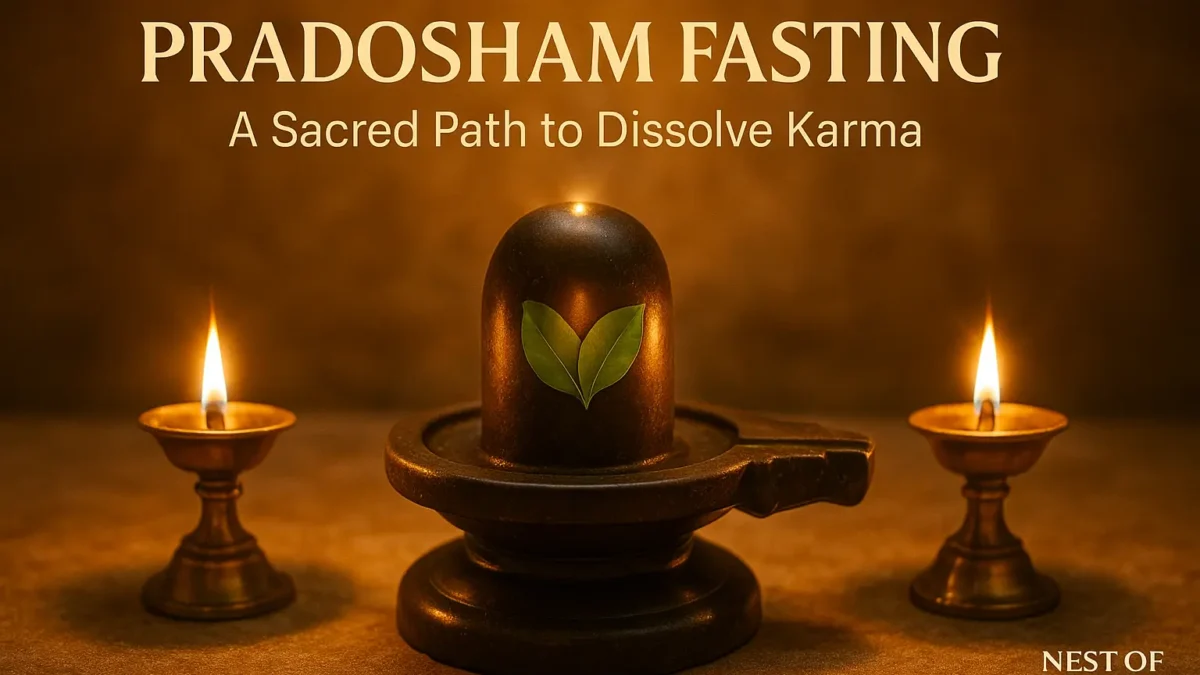Introduction
Pradosham Fasting is one of Shaivism’s most transformative observances for dissolving karma and receiving Lord Shiva’s grace. It is observed twice a month on Trayodashi Tithi (13th lunar day) and is revered as the time when Shiva is especially receptive to sincere prayers and remedies.
This complete, practical guide to Pradosham Fasting covers origins, auspicious timing, step-by-step puja, mantras, sattvic diet, common mistakes, temple etiquette, Tamil insights, and FAQs—so you can observe it at home confidently and consistently.
🌿 பிரதோஷ விரதம்—கர்ம நிவர்த்திக்கும் சிவஅருளுக்கும் வழித்திறப்பு.
Table of Contents
- What is Pradosham?
- When is Pradosham Observed?
- Spiritual Significance & Scriptural Notes
- Types of Pradosham (Weekday Focus)
- 7 Powerful Benefits of Pradosham Fasting
- How to Do Pradosham Fasting (Step by Step)
- Sattvic Diet & Breaking the Fast
- Do’s and Don’ts
- Essential Mantras for Pradosham
- Home Puja Tips & Common Mistakes
- Temple Etiquette & Regional Traditions
- Sacred Symbols: Bilva, Rudraksha & Lamps
- Calendar Planning & Consistency
- Common Questions (FAQs)
- Internal Links
- External References
- Conclusion
What is Pradosham?
“Pradosha” literally means removal of faults or dissolution of sins. During Samudra Manthan (ocean churning), the deadly Halahala poison emerged. To save creation, Shiva consumed it. Devas prayed to him during dusk—the sacred window called Pradosha Kala. From then on, devotees observe Pradosham Fasting to cleanse karma and invite divine compassion.
Pradosham Fasting is multidimensional—combining fasting, abhishekam, bilva offerings, mantra japa, contemplation, and charity—making it one of the most potent vratams for inner purification.
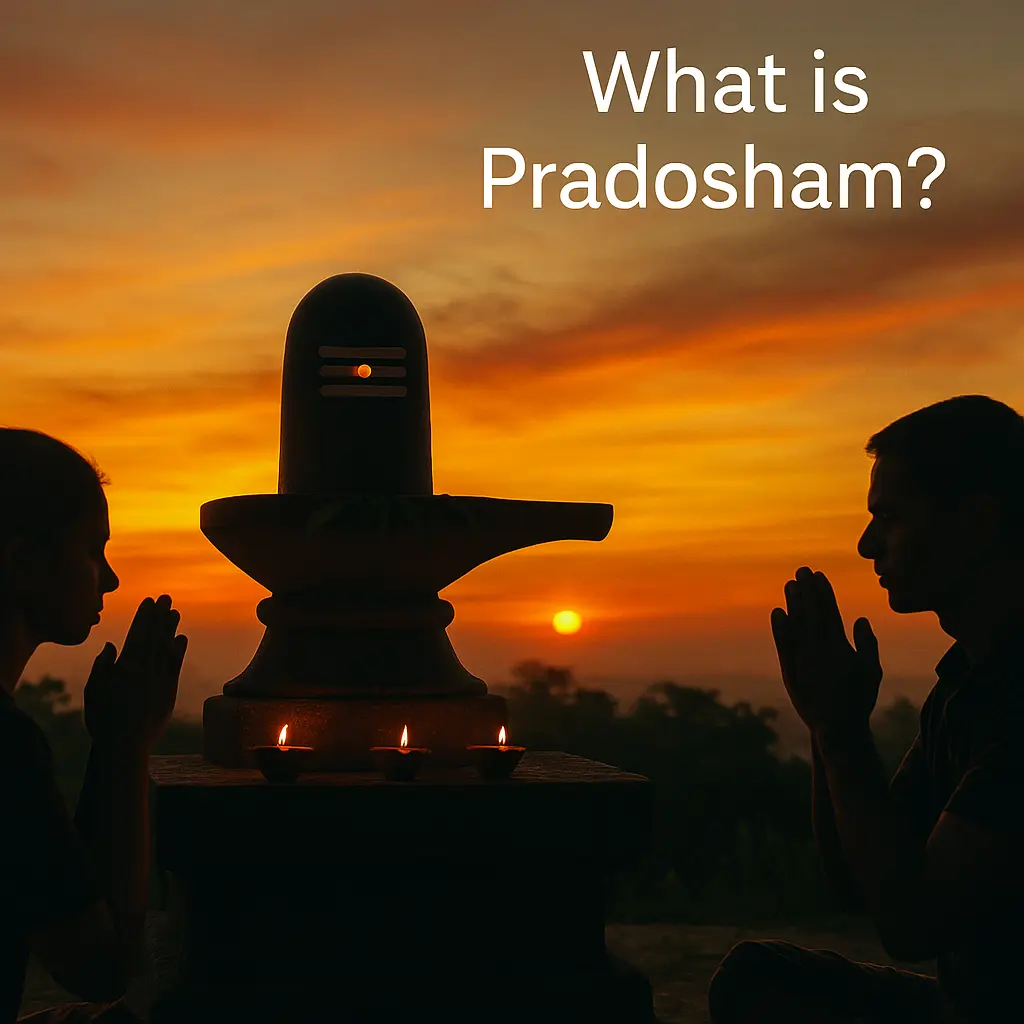

When is Pradosham Observed?
Pradosham occurs twice every lunar month:
- On Shukla Paksha Trayodashi (waxing phase)
- On Krishna Paksha Trayodashi (waning phase)
The most auspicious period is the Pradosha Kala, approximately 1.5 hours before and after local sunset. Align your Pradosham Fasting puja within this window for maximum benefit.
🌿 சூரிய அஸ்தமனத்துக்கு முன்னான காலமே பிரதோஷ நேரம்—அருள் மிகும் தருணம்.
Spiritual Significance & Scriptural Notes
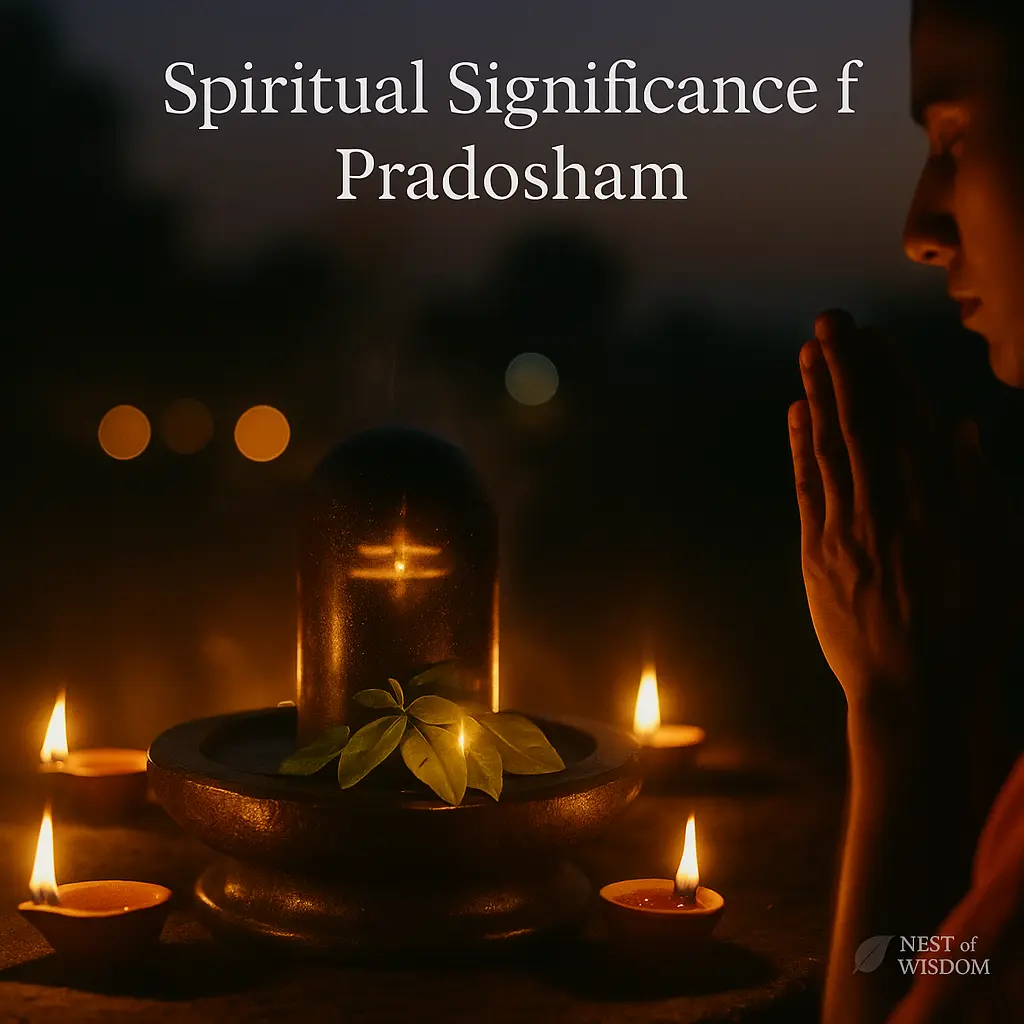

Scriptural traditions (e.g., Puranic narratives) affirm that Pradosham Fasting is a doorway to Shiva’s grace. Devotees pray for purification of past karmas, removal of doshas, and elevation towards Moksha (liberation). Observance with sincerity is said to dissolve obstacles in health, career, marriage, and finances.
Unlike routine fasts, the Pradosham vrata integrates inner discipline (niyama) with outer worship. The synergy of fasting, abhisheka, bilva offerings, and mantra japa amplifies the impact of your practice—and keeps Pradosham Fasting grounded in devotion over formality.
✅ Key idea: Bhava (devotional feeling) matters as much as the ritual. Even a simple, sincere Pradosham Fasting at home can be profoundly effective.
Types of Pradosham (Weekday Focus)
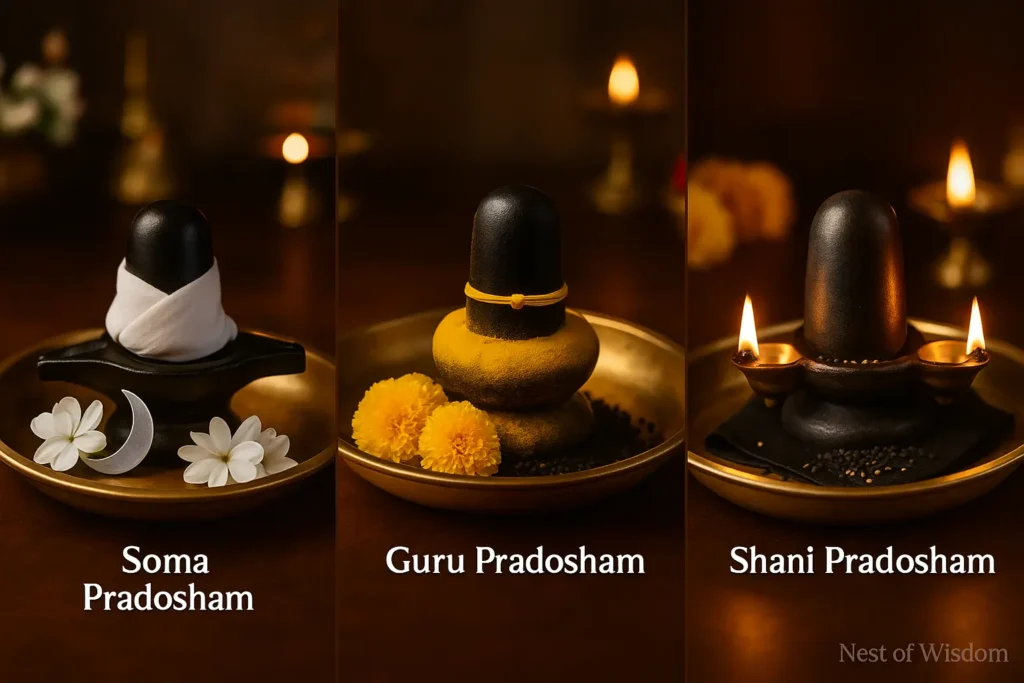

- Soma Pradosham (Monday): Chandra’s day—excellent for emotional healing, peace, and mind–heart balance.
- Guru Pradosham (Thursday): For wisdom, teachers’ blessings, prosperity, and Guru dosha relief.
- Shani Pradosham (Saturday): Considered the most powerful for karmic cleansing and Saturn-related challenges.
When Pradosham coincides with Monday or Saturday, many observe Pradosham Fasting with heightened austerity and longer mantra japa counts.
7 Powerful Benefits of Pradosham Fasting
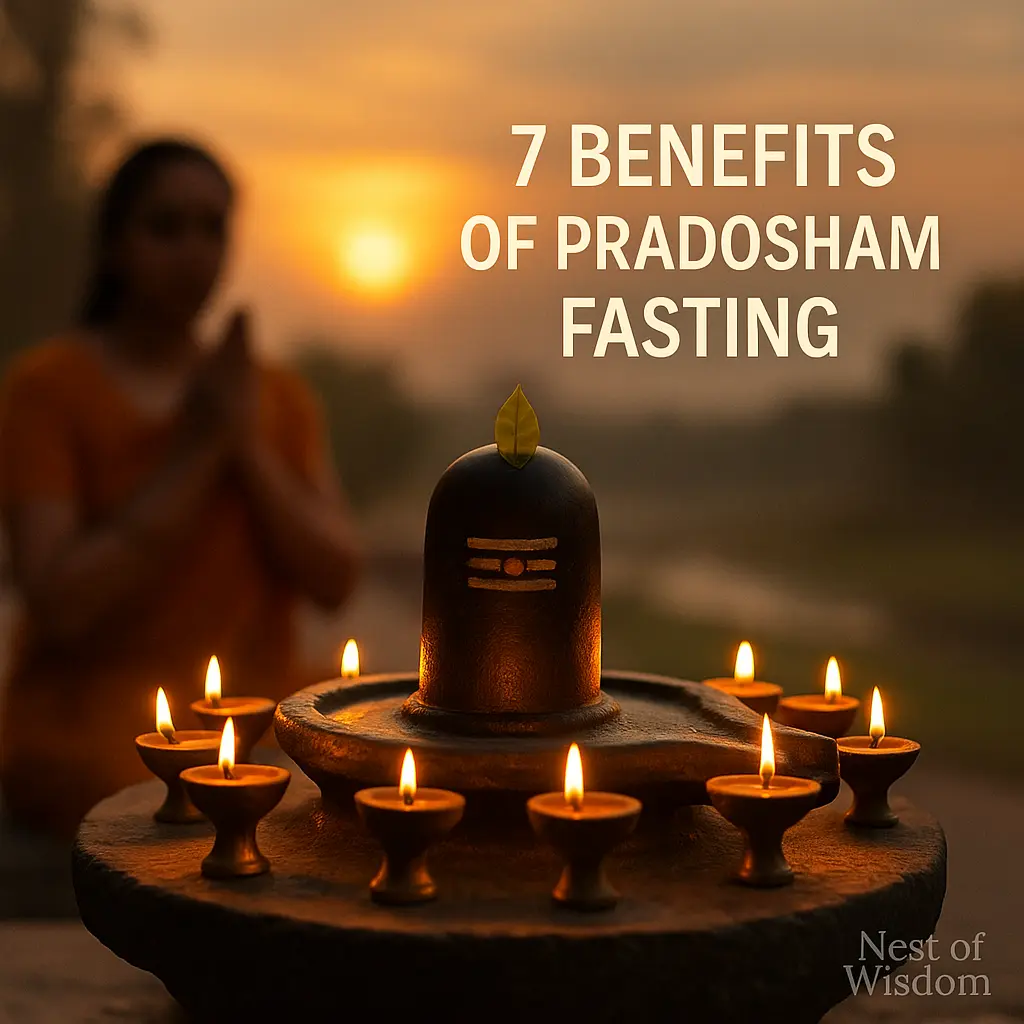

- Karma Cleansing: Dissolves negative patterns and past-life impressions.
- Mental Clarity: Cultivates calm, discipline, and purpose.
- Health & Vitality: Supports digestive reset and sattvic balance.
- Prosperity & Career: Removes stagnation; invites new opportunities.
- Relationship Harmony: Reduces friction and fosters empathy.
- Planetary Relief: Eases adverse influences symbolically through sincere worship.
- Spiritual Progress: Deepens devotion and leads toward Moksha.
🌿 பிரதோஷ விரதம் பக்தியைப் பெருக்கி மனக் களங்கத்தை நீக்குகிறது.
How to Do Pradosham Fasting (Step by Step)
If you’re starting Pradosham Fasting, use this simple framework and adapt it to your household:
🌼 Preparation (Morning)
- Wake early, bathe, and wear clean, light-colored clothes (white preferred).
- Keep a gentle fast according to your capacity: water-only, fruit-only, or milk-only until evening.
- Clean the puja space; gather bilva leaves, white flowers, sandal paste, lamp oil, incense.
- Optional: 9–12 minutes of pranayama and silent japa to set intention for Pradosham Fasting.
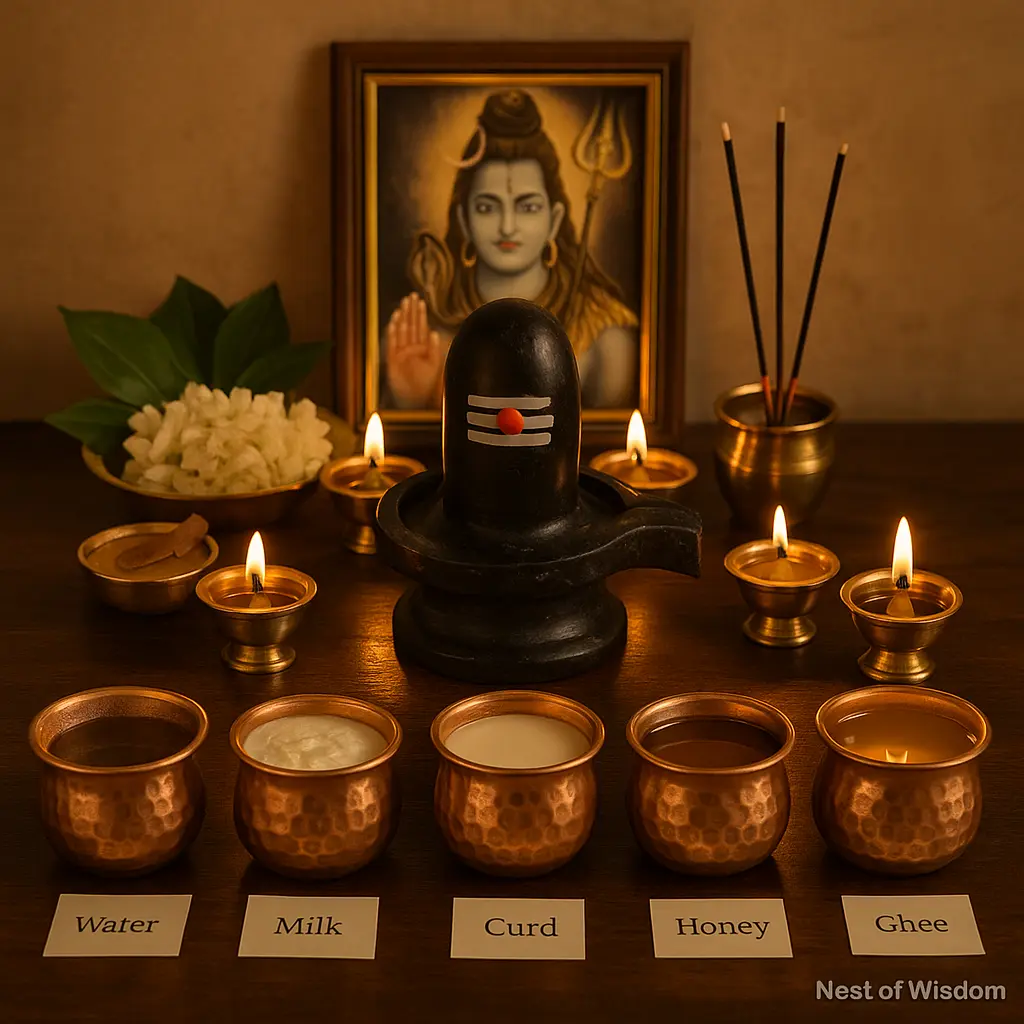

🕯️ Altar Setup (Before Sunset)
- Place a Shiva Lingam or Shiva photo facing East.
- Light five oil lamps; offer sandal, incense, and flowers.
- Arrange water, milk, curd, honey, and ghee for abhishekam (if performing).
- Keep a small plate for naivedyam (banana, coconut, jaggery, or seasonal fruit).
🕉️ Main Puja During Pradosha Kala
Time your puja within the 1.5 hours before and after sunset:
- Pray and set a clear intention (karma cleansing, peace, prosperity).
- Abhishekam: sequentially with water → milk → curd → honey → ghee → water.
- Wipe the Lingam; decorate with bilva leaves and white flowers.
- Chant the Maha Mrityunjaya Mantra (108× or as possible).
- Perform aarti; offer naivedyam; sit in silence for a minute.
📿 Maha Mrityunjaya Mantra
ॐ त्र्यम्बकं यजामहे सुगन्धिं पुष्टिवर्धनम् ।
उर्वारुकमिव बन्धनान् मृत्योर्मुक्षीय माऽमृतात् ॥
You can also recite Om Namah Shivaya (108×) alongside your Pradosham Fasting puja.
Sattvic Diet & Breaking the Fast
Keep food light, pure, and sattvic during Pradosham Fasting. Depending on tradition and health, you may choose:
- Nirjala: No food or water until completion (advanced only).
- Phalahar: Fruits, milk, curd, nuts, and jaggery-based prasad.
- Light Satvik Meal (After Puja): Moong dal, plain rice or millet, steamed veggies, ghee, rock salt (if permitted).
Breaking the Fast: After evening aarti, take a small prasad first; then consume a simple sattvic meal. Avoid onion, garlic, heavy spices, and tamasic foods.
Do’s and Don’ts During Pradosham Fasting
Do’s:
✅ Maintain calm speech and thoughts.
✅ Keep your environment clean and devotional.
✅ Offer charity (annadanam/dakshina) if possible.
✅ Read a short passage on Shiva or write “Om Namah Shivaya” 108×.
Don’ts:
❌ Avoid anger, gossip, and harsh words.
❌ No alcohol or non-vegetarian food.
❌ Don’t leave the puja incomplete; keep lamps supervised.
❌ Avoid heavy digital distraction during the puja window.
🌿 அனுஷ்டானத்தின் சுத்தமும் தெளிவும்—விரதத்தின் பலன் உயரச் செய்கிறது.
Essential Mantras for Pradosham
- Om Namah Shivaya — universal, powerful, and simple.
- Maha Mrityunjaya (above) — for protection and renewal.
- Bilvashtakam (optional) — when offering bilva leaves.
Set a realistic count (11×, 27×, 54×, or 108×). In Pradosham Fasting, sincerity outweighs speed.
Home Puja Tips & Common Mistakes
- Simple is okay: A clean photo of Shiva suffices if Lingam isn’t available.
- Water-first principle: Always begin abhishekam with water.
- Bilva leaves: Offer 3-leaf clusters facing upwards; avoid damaged leaves.
- Time mindfulness: Anchor your main puja in the Pradosha Kala.
- Gentle pace: Avoid rushing mantras just to hit a number; quality matters in Pradosham Fasting.
- After-care: Extinguish lamps safely; distribute prasad mindfully.
Temple Etiquette & Regional Traditions
If observing Pradosham Fasting at a temple:
- Arrive early to settle the mind; keep phones silent.
- Follow the priest’s guidance for archanai/abhishekam; offer bilva respectfully.
- Join the collective Om Namah Shivaya chanting; maintain silence otherwise.
- Accept prasad with the right hand; avoid waste.
Regional variations: South Indian temples may emphasize bilva and ghee lamps; North Indian traditions may include specific bhajans; diaspora temples often adapt timings to local sunset while retaining the heart of Pradosham Fasting.
Sacred Symbols: Bilva, Rudraksha & Lamps
Bilva (Bael) Leaves: The three leaflets symbolize Shiva’s trident or the purifications of body–mind–speech. In Pradosham Fasting, bilva is considered the most beloved offering to Shiva.
Rudraksha: Wearing a clean rudraksha mala during puja supports focus and devotional energy; it’s optional yet traditional.
Deepam (Lamps): Five lamps symbolize the pancha bhutas (five elements). Keeping the flame steady represents inner steadiness cultivated during Pradosham Fasting.
Calendar Planning & Consistency
To maintain Pradosham Fasting smoothly throughout the year:
- Mark every Trayodashi on your calendar (both phases each month).
- Prepare a small kit: bilva, cotton wicks, oil, sandal, incense, and a printout of mantras.
- Choose a sustainable fasting style (fruits/milk) rather than extreme austerity you can’t maintain.
- If you miss the exact time due to work, do a shorter puja with deep bhava—consistency over perfection.
Common Questions About Pradosham
Q1. Can beginners observe Pradosham Fasting?
Yes. Even partial fasting and a simple evening puja bring blessings. Focus on consistency and bhava.
Q2. What if I cannot fast fully?
You can take fruits/milk and still perform puja. Pradosham Fasting values sincerity over strictness.
Q3. Is Pradosham only for Shaivites?
No. Anyone can observe it respectfully to purify karma and seek divine grace.
Q4. Can I do Pradosham at home without a Shiva Lingam?
Yes. A clean Shiva photo is acceptable. Keep the space pure and devotional.
Q5. Which day is most powerful for Pradosham Fasting?
Many consider Monday and especially Saturday (Shani Pradosham) highly potent.
Q6. How many months should I observe?
Some follow every Trayodashi; others commit to 3, 6, or 12 months. Choose a sustainable rhythm.
Q7. What if I’m traveling or at work during Pradosha Kala?
Do a brief Pradosham Fasting puja mentally or with a small lamp later the same evening; intention matters.
Q8. Can I combine Pradosham with other vratas?
Yes, but keep the mind calm—avoid overloading yourself. Prioritize sincere Shiva puja during the dusk window.
Internal Links
Explore more vrat and mantra guides to pair with your Pradosham Fasting practice:
- 🕉️ Om Namah Shivaya – Meaning & Benefits
- 🌗 Ekadashi Fasting – Benefits & Rituals
- 💫 Navratri Fasting – Complete Guide
- 🕯️ Wednesday Fasting (Budhvar Vrat) – Rituals & Benefits
External References (General Background)
Disclaimer: Scriptural practices vary by lineage and region. Follow your family guru/temple guidance where applicable.
Conclusion
Pradosham Fasting is a twice-monthly doorway to Shiva’s compassion. By aligning your puja with the Pradosha Kala, keeping a sattvic mind and diet, and chanting with devotion, you steadily dissolve karmic residue and invite clarity, protection, and spiritual growth into daily life.
🌿 சிவாய நம—அருள் நிலை பெருகட்டும்.
Nest of Wisdom Insights is a dedicated editorial team focused on sharing timeless wisdom, natural healing remedies, spiritual practices, and practical life strategies. Our mission is to empower readers with trustworthy, well-researched guidance rooted in both Tamil culture and modern science.
இயற்கை வாழ்வு மற்றும் ஆன்மிகம் சார்ந்த அறிவு அனைவருக்கும் பயனளிக்க வேண்டும் என்பதே எங்கள் நோக்கம்.
- Nest of Wisdom Authorhttps://nestofwisdom.com/author/varakulangmail-com/
- Nest of Wisdom Authorhttps://nestofwisdom.com/author/varakulangmail-com/
- Nest of Wisdom Authorhttps://nestofwisdom.com/author/varakulangmail-com/
- Nest of Wisdom Authorhttps://nestofwisdom.com/author/varakulangmail-com/
Related posts
Today's pick
Recent Posts
- Internal Linking Strategy for Blogs: A Practical, Human-Centered Playbook
- AI in the Automotive Industry: A Practical, Human-Centered Guide
- Cloud Tools for Small Businesses and Freelancers: The Complete Guide
- Generative AI in Business: Real-World Use Cases, Benefits & Risks
- 7 Life-Changing Daily Habits for Weight Loss Without Dieting

